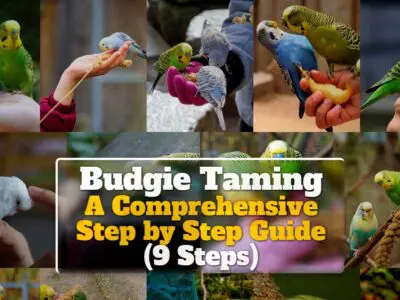Your interaction with your budgie should be marked by patience and trust-building.
Speak softly in a soothing tone, avoiding loud noises that may startle the bird.
Spend quality time daily, with consistency in routine and activities like talking and playing. Non-verbal communication, like understanding your budgie’s body postures, is equally crucial.
As someone who has enjoyed the company of these lively little birds and deeply appreciates the joy they bring, I find immense pleasure in guiding fellow bird enthusiasts in enhancing their relationships with their pet budgies.
I planned this content because I recognize a need for comprehensive, beginner-friendly guidance for new budgie owners.
Having observed, read, and even owned a budgie, I am aware of the specific queries and challenges that many people encounter, especially when it comes to effective communication and bonding with their feathered friends.
From this enriched perspective, I decided to create a content piece that is informed by personal experiences, meticulous readings, and keen observations from numerous bird-care videos and materials.
With a history of owning budgies and an ever-growing interest in bird-care, I planned and developed this step-by-step guide on “How to Talk & Treat a Budgie.” My decision was informed by my personal experiences, comprehensive readings, and visual materials, aiming to assist new budgie owners in fostering a profound bond with their beloved pets.
While this guide does provide strategies for encouraging your budgie to talk, its primary focus is on teaching humans how to interact and bond with their budgie in a meaningful way.
It’s vital to understand that budgies, like all animals, need a nurturing, respectful, and compassionate environment to feel safe and loved.
It’s about more than just getting them to mimic human speech; it’s about treating them in a way that enhances their well-being.
Interestingly, as you develop this bond and your budgie becomes more comfortable in its surroundings, it may naturally begin to mimic sounds and words, reflecting their happier state.
In essence, your budgie’s ability to talk can be an additional, delightful outcome of a well-treated, content budgie.
Creating A Comfortable Environment
Before we can embark on the journey of learning to communicate with our budgie, we need to lay the foundation by creating a comfortable environment for our feathered friend.
After all, a bird that feels safe and secure in its surroundings is more likely to open up and interact positively.
A safe and secure living space is a critical element in this regard.
The cage you choose should be spacious enough for your budgie to fly and move around comfortably.
It should also have a variety of perches and toys to keep your budgie engaged and active.
Choosing a quiet location for the cage is another crucial factor.
Budgies, like all birds, can be easily startled by loud noises or sudden movements.
Placing the cage in a calm, less trafficked area of your home can help minimize distractions and stress for your bird.
Last, but definitely not least, it’s important to maintain appropriate temperature and lighting conditions in the budgie’s living area.
Budgies thrive in temperatures between 65 to 75 degrees Fahrenheit (equivalent to approximately 18 to 24 degrees Celsius), and they need ample natural light during the day and darkness at night to maintain a healthy sleep-wake cycle.
Establishing Trust And Building Rapport
Once the physical environment is set, the next crucial step in building a bond with your budgie is to establish trust and rapport.
This is where patience and understanding play a pivotal role.
Your budgie may need some time to acclimate to its new environment.
It’s important to allow them this time and not rush the process.
Spend time near the cage, speaking softly and calmly.
This not only helps the budgie to get used to your presence but also provides an opportunity for them to pick up on your voice and begin associating it with safety and comfort.
An effective strategy for winning your budgie’s trust is to offer treats as a positive reinforcement for desirable behavior.
This not only encourages your budgie to engage in those behaviors more often but also associates your presence with positive experiences, thus fostering trust and rapport over time.
Tone And Voice Modulation
When communicating with your budgie, your tone and the way you modulate your voice can significantly influence the bond you’re trying to build.
It’s important to use a gentle, soothing tone when speaking to your budgie.
Just like humans, budgies too respond well to a calm and pleasant voice.
It helps in creating an environment of safety and trust, which is crucial for their well-being and your budding friendship.
Conversely, sudden loud noises can be highly distressing for your feathered friend.
Budgies, as prey animals, are wired to be alert to potential dangers.
Loud noises can startle or frighten your budgie and create an environment of stress and fear.
So, it’s important to maintain a peaceful, quiet environment to foster a relaxed and trusting relationship with your budgie.
Don’t be afraid to experiment with different pitches and rhythms.
Budgies are highly intelligent and curious birds, and they’re drawn to intriguing sounds.
You might notice that your budgie responds more actively to a certain pitch or rhythm.
Take note of these preferences, as they can be valuable tools in strengthening your bond.
Consistency And Regular Interaction
Moving to the next essential aspect of human-budgie communication: consistency and regular interaction.
Budgies, like many other pets, thrive on routine.
They feel more secure and comfortable when their daily life follows a predictable pattern.
Therefore, try to maintain a consistent daily routine with your budgie.
Interacting with your budgie each day, preferably at the same time, helps build that routine and sense of familiarity.
Even if you’re busy, try to allocate some dedicated time each day to spend with your budgie.
Whether it’s first thing in the morning or after you get home from work, a fixed schedule helps reinforce the routine and offers your budgie a sense of security.
Incorporating activities like talking, singing, and playing together into your daily interaction routine not only keeps your budgie entertained but also opens up channels for communication and bonding.
Experiment with different activities and note what your budgie enjoys the most.
That could be your special bonding time.
Speaking Clearly And Enunciating Words
Now that we’ve covered the importance of tone, voice modulation, consistency, and regular interaction, let’s delve into the specifics of speech.
If you want your budgie to pick up words and sounds, it’s essential to speak slowly and clearly, emphasizing words and sounds.
Budgies are great mimics, but they need clear models to replicate the sounds accurately.
Moreover, enunciating words can aid your budgie in understanding and mimicking sounds.
Remember, your budgie doesn’t understand the meaning of words as we do; they are replicating the sounds.
By pronouncing words distinctly, you give your budgie the best chance to imitate the sounds correctly.
Lastly, using simple, repetitive phrases or words can aid in learning and recognition.
When your budgie hears the same word or phrase repeatedly, they’re more likely to remember and reproduce the sounds.
Think of phrases like “good birdie” or “hello” as good starting points.
Patience is key here.
Remember, it might take some time before your budgie starts mimicking your speech, but the wait is worth it!
Active Listening And Responsiveness
Active listening and responsiveness are pivotal in fostering strong and effective communication with your budgie.
Budgies are expressive creatures; they communicate through their body language and vocalizations.
Thus, it’s vital to pay close attention to these cues and respond appropriately.
Your budgie’s posture, feather placement, and eye movement can provide valuable insights into their mood and comfort levels.
Similarly, different chirps, tweets, and squawks can indicate excitement, contentment, anxiety, or curiosity.
By responding to these cues, you acknowledge and validate your budgie’s attempts at communication, fostering a deeper bond.
Engage in turn-taking conversations.
This doesn’t mean waiting for your budgie to start talking in human language.
It can be as simple as pausing after you say something, allowing your budgie to respond with a chirp or a gesture.
Over time, this can cultivate a communication pattern that your budgie recognizes and participates in.
Avoiding Negative Reinforcement
In any form of animal training or interaction, it’s crucial to avoid negative reinforcement.
This means you should refrain from yelling, shouting, or scolding your budgie.
Not only can this startle and frighten your budgie, but it can also lead to a breakdown of trust and communication.
Never punish your budgie for unwanted behaviors.
Unlike humans, budgies don’t understand the concept of punishment.
Instead, it may induce stress and fear, which can be detrimental to your bonding process.
Instead, try to redirect undesired behavior with positive reinforcement and distractions.
For instance, if your budgie is chewing on something they shouldn’t, distract them with a favorite toy or treat.
Non-Verbal Communication
Aside from verbal cues, non-verbal communication plays a significant role in human-budgie interaction.
It’s essential to utilize body language to communicate your intentions and feelings to your budgie.
Understanding your budgie’s body postures and gestures is a critical part of this process.
A relaxed, fluffed-up budgie is likely content, while a budgie with slicked-down feathers might be anxious.
Conversely, gentle movements and positive body language from you can reassure your budgie and help establish trust.
Eye contact can also play a significant role in building trust.
However, be mindful that direct, prolonged eye contact can sometimes be seen as a threat, so it’s crucial to find a balance.
Developing A Vocabulary
As part of the bonding process, you may want to teach your budgie to mimic human speech.
Introduce a range of words, phrases, and sounds to your budgie.
Remember to use context and repetition to help your budgie understand word meanings.
Encourage mimicry by reinforcing successful attempts at communication.
Whenever your budgie makes an attempt at mimicking a word or sound, reward them with a treat or a head scratch.
Over time, this positive reinforcement can encourage your budgie to try new words and sounds.
Conclusion
In conclusion, effective human-budgie communication relies on a myriad of factors.
These include creating a comfortable environment, establishing trust, using appropriate voice modulation, ensuring regular interaction, speaking clearly, actively listening, avoiding negative reinforcement, understanding non-verbal cues, and encouraging vocabulary development.
The journey of bonding with your budgie is one of patience, consistency, and positive reinforcement.
Inculcating these tips into your interaction routine can strengthen the bond you share with your budgie, enhancing your mutual understanding and companionship.
Remember, each budgie is unique, and it may take time to find what works best for both of you.
Enjoy the journey of discovery and bonding that lies ahead!
Faqs
Can My Budgie Learn To Understand My Speech?
Yes, with consistent and patient training, your budgie can learn to understand simple phrases or words.
Regular interaction using clear enunciation can significantly help in this learning process.
Reinforce your budgie’s attempts at mimicry with positive rewards, gradually building a shared vocabulary.
What Does Negative Reinforcement Do To My Budgie?
Negative reinforcement, such as shouting or scolding, can cause your budgie to become scared or anxious.
This could hinder your efforts to establish a trusting relationship.
Instead, focus on positive reinforcement techniques like offering treats for desirable behavior and using distractions to redirect undesired actions.
How Can Non-Verbal Communication Enhance My Bond With My Budgie?
Non-verbal communication plays a vital role in bonding with your budgie.
Understanding and responding to your budgie’s body language can help establish trust.
Simple actions like maintaining gentle movements, offering treats, and making eye contact can convey a sense of security and affection to your budgie.
What Role Does Routine Play In My Interaction With My Budgie?
A consistent routine provides a sense of predictability and comfort to your budgie.
Regular interaction times, consistent feeding, and play schedules can foster trust and familiarity.
Try to interact with your budgie at the same time each day to reinforce this routine.
Can I Use Different Tones And Rhythms When Speaking To My Budgie?
Absolutely, experimenting with different tones, pitches, and rhythms can capture your budgie’s attention and make the interaction more engaging.
However, avoid sudden loud noises as these can startle your budgie.
A gentle, soothing tone is usually the most effective when speaking to your budgie.


